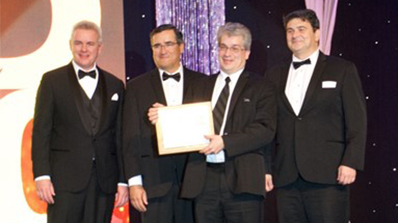NNSS received its sixth R&D 100 Award for its silicon strip cosmic muon detectors project Nov. 16 in Orlando, Florida. The annual conference and awards gala recognizes the 100 most technologically significant new products of the year.
The R&D 100 entry, co-developed with the Fermi National Accelerator Laboratory and Los Alamos National Laboratory (LANL), focuses on drift tube-based technology, which allows silicon strip muon detectors to be embedded into structures without extensive calibration software requirements or the risk of high voltage and flammable gas. Muons are secondary particles that travel down to the Earth’s surface and arrive at a wide variety of angles and energies when cosmic rays collide with the Earth’s atmosphere. Muon detectors enable trackers to recognize shielded nuclear materials, explosives and other items of interest. The identification process allows threats that could be concealed in different types of materials to be recognized. Various implementation options make the silicon strip muon detectors a potentially paramount advantage to maritime safety and homeland security.
“It is a great accomplishment for the Nevada National Security Site and our multi-laboratory team to receive one of this year’s R&D 100 Awards,” said NNSS Strategy Development Manager Robert Koss. “The scientists and engineers who developed this award-winning technology are keeping our nation at the forefront of innovation through contributions to U.S. and global security.”
NNSS previously won five R&D 100 awards for its 2017 Geometrically Enhanced Photocathodes, 2013 KiloPower with LANL, 2012 Multiplexed Photonic Doppler Velocimeter, 2010 Movies of eXtreme Imaging Experiments with LANL and 2009 High-Resolution Holography Lens entries. NNSS was also a finalist for its Argus Fisheye Probe in 2015.

